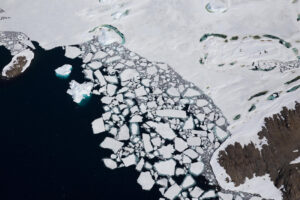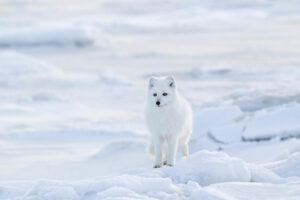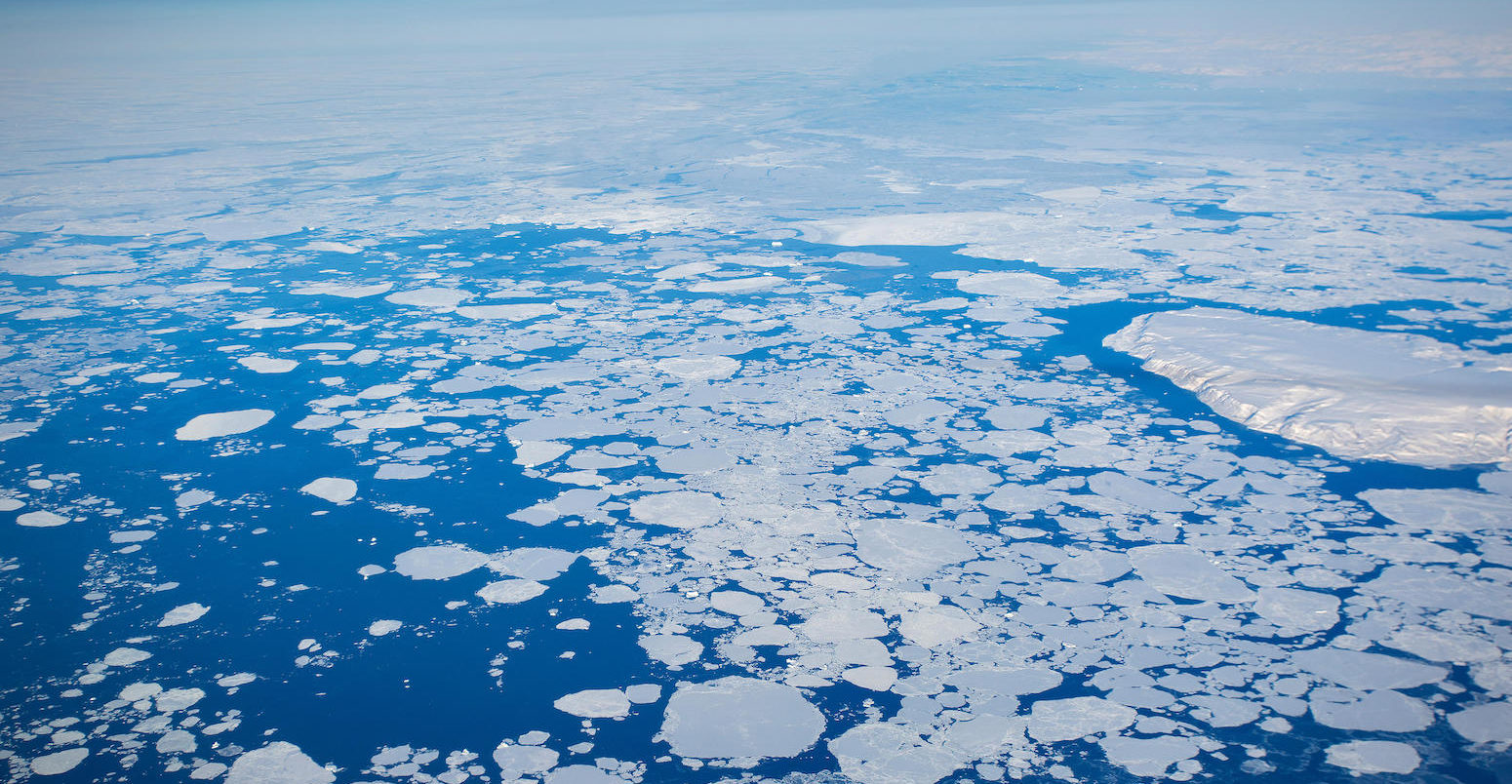
The Arctic has warmed ‘nearly four times faster’ than the global average
Ayesha Tandon
08.11.22Ayesha Tandon
11.08.2022 | 4:00pm“Arctic amplification” may be stronger than previously thought, according to new research.
The phenomenon means Arctic temperatures are rising much faster than the global average, with previous estimates finding the region is warming two times as quickly.
However, new research published in Communications Earth and Environment suggests that the Arctic has warmed nearly four times faster than the global average over the past four decades.
The authors find that climate models “struggle” to accurately simulate Arctic amplification, consistently underestimating its value. However, scientists not involved in the research note that there are uncertainties in observations of Arctic warming for the regional definition chosen, and advise caution in this conclusion.
The study is “inspirational”, a scientist not involved in the study tells Carbon Brief, adding that it will raise awareness about the “limitation of current climate models in fully capturing some critical physical processes that drive Arctic Amplification in the real world”.
Arctic amplification
Global temperatures have already increased by around 1.3C due to human activity. However, warming is not consistent across the planet – some regions have warmed significantly faster than others. The Arctic is a hotspot for global warming, and has seen local temperatures rise much faster than the global average in recent decades – a phenomenon known as Arctic amplification.
In this study, the authors use observational data to investigate how temperatures in the Arctic circle have changed since 1950. The plot below shows temperatures in the Arctic circle (dark lines) and global average temperatures (faded lines), compared to the average 1981-2010 temperature. Each colour represents a different dataset of observations.
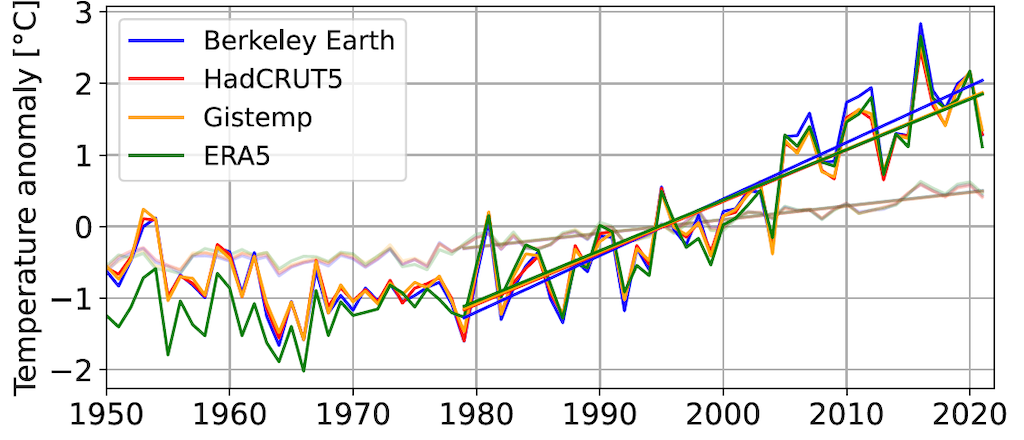
The graph shows that temperatures in the Arctic have warmed 3.8 times faster than the global average since the late 1970s.
This value is much higher than the numbers cited by previous studies. The latest report from the Intergovernmental Panel on Climate Change says “it is very likely that the Arctic has warmed at more than twice the global rate over the past 50 years”. Meanwhile, the recent Arctic Monitoring and Assessment Programme report says that the Arctic is warming three times faster.
It can be tricky to estimate the rate of Arctic amplification, because uncertainty in Arctic warming is inherently high in models, Dr Matthew Henry – a postdoctoral research fellow at the University of Exeter, who was not involved in the study – tells Carbon Brief:
“The uncertainty in the magnitude of Arctic warming is inherently larger than that of global warming. Global warming uncertainty is mainly due to cloud feedbacks, whereas Arctic warming uncertainty arises from sea ice, cloud, aerosol, and atmospheric and oceanic heat transport processes.”
Rapidly rising Arctic temperatures are driven by a range of processes, including the “surface albedo feedback”, in which melting sea ice uncovers the darker water beneath. This reflects less of the sun’s rays back into space, allowing further warming and melting. Arctic amplification is strongest in the late autumn and early winter, when the ice-free ocean releases heat into the atmosphere.
The Arctic circle
The lack of consensus on Arctic amplification in existing literature is partly because there is no fixed definition of where the Arctic begins and ends. The Arctic can be defined using the area poleward of a given latitude – 60N, 65N and 70N are often used – but there are also definitions not based on latitude, the study notes.
This is important because warming is not uniform across the Arctic. The maps below show warming per decade (left) and Arctic amplification across the northern polar region (right), using the average of four observational datasets. The Arctic circle – defined at 66N latitude – is shown by the dotted line.
Darker colours in the map on the left indicate faster decadal warming. In the map on the right, values above one indicate that the area is warming faster than the global average. For example, a value of two means the area is warming twice as fast as the global average.
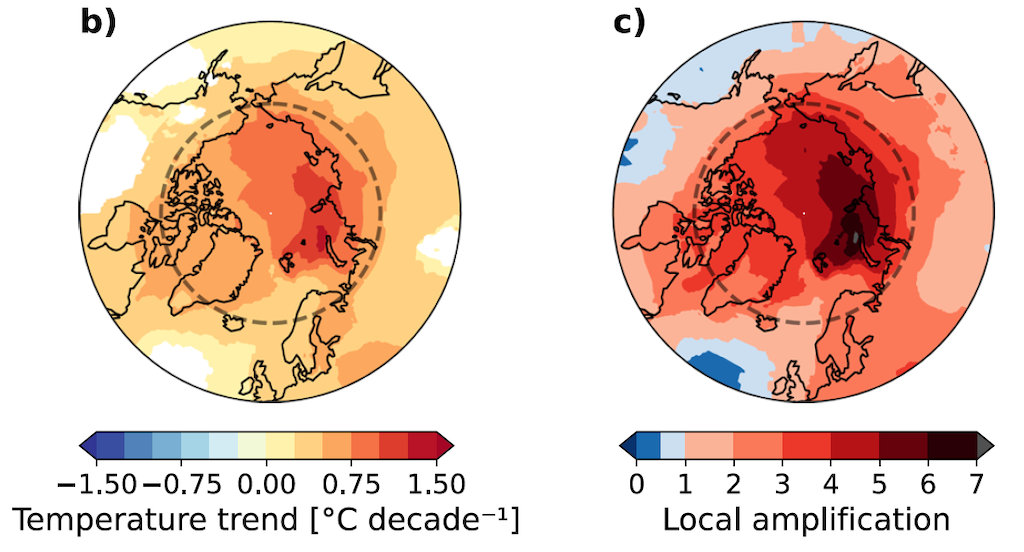
The map on the right shows that across the Arctic circle, Arctic amplification is always greater than two. However, there is variation within the region. For example, warming is seven times faster than the global average in the Barents sea, where ice melt during the cold season is particularly pronounced.
The authors investigate how changing the regional definition and the time window used affects Arctic amplification. Each box in the figure below shows Arctic amplification for a single region and time window. Darker colours indicate a higher Arctic amplification and the star shows the region and time window chosen in this study.
Moving up the chart moves the boundary used to define the Arctic region closer to the pole. Meanwhile, moving from left to right increases the time window over which Arctic amplification is calculated. For example, 10 years on the x axis corresponds to the trend calculated over 2011–21, and 30 years corresponds to 1991-2021.
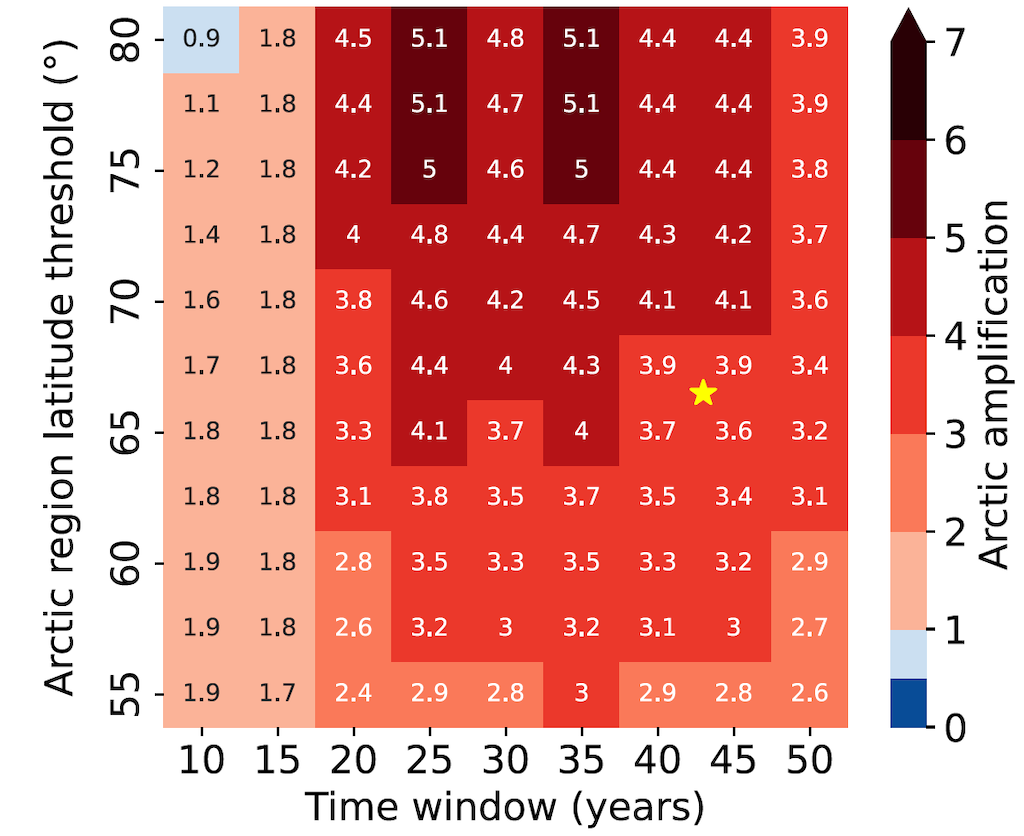
The plot shows that Arctic amplification can range from around one – indicating that the Arctic is warming at the same rate as the rest of the planet – to more than five, depending on the time period and region studied.
In this study, the authors focus on the Arctic circle. Dr Mika Rantanen – a researcher at the Finnish Meteorological Institute and lead author on the study – tells Carbon Brief that this definition was chosen in part because it is “the most commonly used”.
The authors analyse trends over 1979-2021 because the observations are more accurate over this period, and because the late 1970s saw Arctic temperatures begin to rise rapidly. On average, the study finds that the planet as a whole warmed by 0.19C per decade, while the Arctic warmed 3.8 times faster – at 0.73C per decade.
Dr Judah Cohen – director of seasonal forecasting at Atmospheric and Environmental Research (AER), who was also not involved in the study – tells Carbon Brief that “most amplified warming is over the ocean”. As such, the high Arctic amplification found in this study is in part because the regional definition excludes most of the Arctic lands, he says.
The authors find that using a shorter, more recent time window results in a lower Arctic amplification – indicating that in recent decades, the Arctic has warmed at a similar speed to the rest of the planet. This could mean that warming in the Arctic has slowed down, or warming in the rest of the world has sped up, Rantanen tells Carbon Brief.
This finding “highlights the importance of exploring the sensitivity of Arctic amplification to its definition”, Prof Karen Smith – an assistant professor at the University of Toronto Scarborough, who was not involved in the study – tells Carbon Brief.
Underestimate
The authors also use models from the sixth Coupled Model Intercomparison Project to simulate warming in the Arctic circle over 1979–2021. To assess how accurate the models are, they compare the model results to observations.
CMIP6 models which closely replicate the observed Arctic warming trends typically show “too much” global warming, the authors find. Meanwhile, models which accurately simulate global warming closely show “too weak” Arctic warming. The study concludes:
“The recent four-fold Arctic warming ratio is either an extremely unlikely event, or the climate models systematically tend to underestimate the amplification.”
As such, Rantanen tells Carbon Brief that “state of the art climate models, like CMIP5 and CMIP6, really struggle to simulate this kind of four times faster warming”. However, both Smith and Henry note that there are uncertainties in observations of Arctic warming for the regional definition chosen, and advise caution in this conclusion.
The authors do not directly investigate why the models “struggle” to simulate Arctic amplification, but they speculate about possible reasons. For example, they note that CMIP6 models “fail to simulate plausible sensitivity of Arctic sea-ice loss to the rise of global temperatures”.
The authors highlight that natural variability plays a strong role in the Arctic climate, citing a study, which finds that up to half of recent sea ice loss – a key determinant of Arctic amplification – may be due to internal variability.
Prof Qinghua Ding – an associate professor from the Geography Department at UC Santa Barbara, was not involved in the new study – is lead author of the cited study on natural variability. He tells Carbon Brief that the new work is “interesting and inspirational”.
According to Ding, there is a “significant” connection between Arctic amplification and sea surface temperatures over the past decades that has not been captured well by models. He says that this study has made him “more confident” that a tropical Pacific sea surface temperature cooling trend can contribute to Arctic amplification through a “teleconnection”.
He adds:
“I expect that this study will raise the awareness of the community about the significance of internal variability in contributing to recent Arctic Amplification and the limitation of current climate models in fully capturing some critical physical processes that drive Arctic Amplification in the real world.”
Cohen also notes the importance of natural variability, telling Carbon Brief that models typically underestimate winter cooling in the mid-latitudes. He adds:
“Whether the underestimation of both the Arctic warming and the mid-latitude cooling in the models are physically related, coincidental or related to a third external forcing is at the essence of the debate on whether Arctic warming can force mid-latitude cooling or not.”
The strong influence of natural variability means “it is possible that in the future, [Arctic] amplification might be slightly lower”, Rantanen tells Carbon Brief.
Rantanen et al (2022), The Arctic has warmed nearly four times faster than the globe since 1979, Communications Earth and Environment, doi:10.1038/s43247-022-00498-3
-
‘Arctic amplification’ stronger than previously thought, new research suggests




